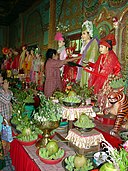Thagyamin

| Thagyamin | |
|---|---|
 The sculpture of Thagyamin in position of chief of nat in Shwezigon Pagoda in Pagan Kingdom. [1][2][3] | |
| Sanskrit transliteration | Shakraj |
| Affiliation | deva, nat, Buddhism in Myanmar, Burmese folk religion |
| Abode | Amarāvati, the capital of Indraloka (Indra's world) in Svarga,[4] Trāyastriṃśa (Heaven of the 33), Mount Meru |
| Weapon | Vajra (Thunderbolt), Astras, Vasavi Shakthi |
| Symbols | Vajra, Indra's net |
| Mount | Airavata (White elephant), Uchchaihshravas (White horse) |
| Texts | deva, nat, Buddhism in Myanmar, Burmese folk religion, Jātakas, Epics |
| Consort | Sujā |
| Equivalents | |
| Greek | Zeus |
| Norse | Thor |
| Roman | Jupiter |
| Slavic | Perun |

Thagyamin (Burmese: သိကြားမင်း, pronounced [ðədʑámɪ́ɰ̃]; from Sanskrit ၐကြ Śakra) is the highest-ranking nat (deity) in traditional Burmese Buddhist belief. Considered as the king of Heaven,[5] he is the Burmese adaptation of the Hindu deity Indra.[6][7][8]
Etymology
[edit]Thagyamin (သိကြားမင်း) is derived from the combination of the Sanskrit word "Shakra" (शक्र; a synonym of Indra) and the Burmese word "Min" (မင်း; a common title meaning Lord/King).[9] He is also known by his nickname ''U Magha'' (ဦးမာဃ) derived from his preexistential name.[10]
Description
[edit]Thagyamin is often portrayed as holding a conch shell in one hand, and a yak-tail fly-whisk in the other, and seated or standing atop a three-headed white elephant (Airavata). He is described as the ruler of the celestial kingdom Trāyastriṃśa (တာဝတိံသာ).
He was designated as the supreme deity of the official pantheon of 37 ahtet nat (အထက်နတ်, upper deities) by King Anawrahta in the 11th century, in an effort to streamline animist and Hindu practices among the populace and merge these practices with Theravada Buddhism. He is the only nat in the official pantheon not to have undergone a sudden and violent death, called a "raw" death (အစိမ်းသေ).
According to Burmese traditional folklore, every year at the first day of Thingyan (the Burmese new year), Thagyamin visits the earth while being invisible. There, he observes every person: he records the names of good people in a golden book, and writes the names of evildoers in a book made of dog-skin leather. On the third day of Thingyan, he returns to heaven.
Gallery
[edit]- A portrayal of the King of gods, Thagyamin
- Thagyamin at the Shwedagon Pagoda
See also
[edit]Counterparts of Thagyamin in other Asian cultures
- Haneullim, the Korean counterpart
- Indra, the Hindu counterpart
- Jade Emperor, the Chinese and Taoist counterpart
- Śakra, the Buddhist counterpart
- Ulgen/Qormusta Tengri, the Turko-Mongolian counterpart
References
[edit]- ^ "Myanmar 10/29/2016 - 11/15/2016".
- ^ "King of Burma High Resolution Stock Photography and Images - Alamy".
- ^ "Pagan Period".
- ^ Dalal, Roshen (2014). Hinduism: an Alphabetical Guide. Penguin Books. ISBN 9788184752779.
- ^ David Eimer, Simon Richard (2017). Lonely Planet Myanmar Travel Guide. Lonely Planet. p. 34. ISBN 9781787010697.
- ^ Kumar, Ravi (2014). Hindu Resurgence in Indonesia. Suruchi Prakashan. p. 77. ISBN 9789381500477.
- ^ ဦး, စံသာအောင် (1979). The Buddhist Art of Ancient Arakan. Yangon, Burma: Daw Saw Saw. p. 65.
- ^ Singer, Noel F. (2008). Vaishali and Indianization of Arakan. Delhi, India: APH Publishing. p. 147. ISBN 9788131304051.
- ^ Myanmar-English Official Dictionary. Yangon, Burma: Department of Myanmar Language Commission. 1993. p. 495.
- ^ "Buddhist Legends, II. 7. How Magha Became Sakka". www.ancient-buddhist-texts.net. Retrieved 2021-08-09.


